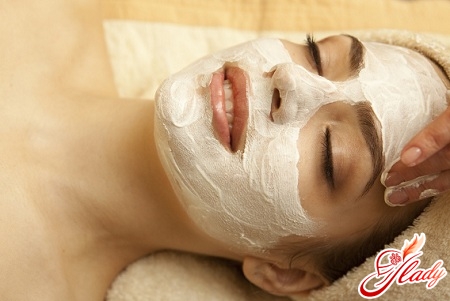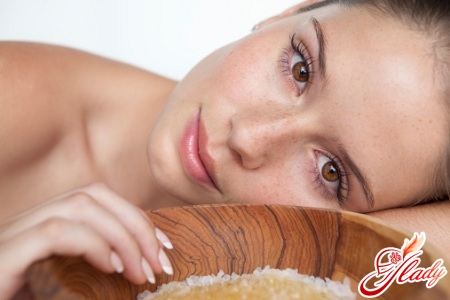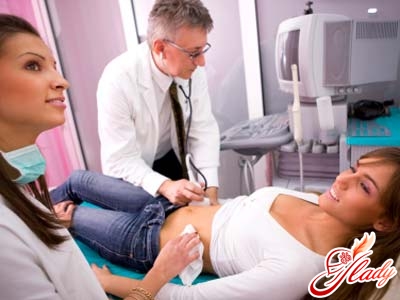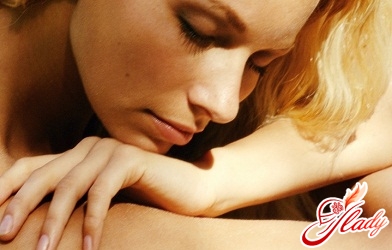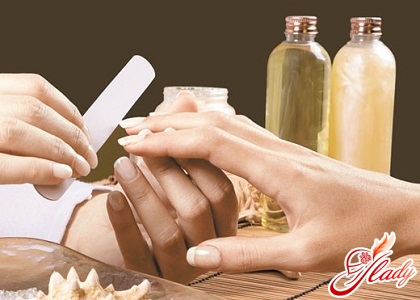 Every woman knows that one is enoughA look at her hands to determine the degree of her respect for herself. A respectable lady gives out beautiful, well-groomed hands. And the main means of caring for the hands from a long time was and remains a manicure. After all, even the word "manicure" in Latin means "hand care" (manus - hand, cur - care). A good manicure involves not only beautifully processed and colored nails; with its help you can successfully get rid of hangnails, moisturize the skin of hands, solve the problem of ingrown nails. However, when preparing for such a useful, necessary and even pleasant procedure, we must remember our security. The master does not need to know just how to use a manicure set. The master must strictly observe the safety precautions. Working with cutting and stabbing tools, the master can inadvertently damage the skin, and there is a risk of getting into the wound infection (bacteria, fungi, herpes, hepatitis, or AIDS)
Every woman knows that one is enoughA look at her hands to determine the degree of her respect for herself. A respectable lady gives out beautiful, well-groomed hands. And the main means of caring for the hands from a long time was and remains a manicure. After all, even the word "manicure" in Latin means "hand care" (manus - hand, cur - care). A good manicure involves not only beautifully processed and colored nails; with its help you can successfully get rid of hangnails, moisturize the skin of hands, solve the problem of ingrown nails. However, when preparing for such a useful, necessary and even pleasant procedure, we must remember our security. The master does not need to know just how to use a manicure set. The master must strictly observe the safety precautions. Working with cutting and stabbing tools, the master can inadvertently damage the skin, and there is a risk of getting into the wound infection (bacteria, fungi, herpes, hepatitis, or AIDS)
What kind of manicure is less traumatic?
There are different types of manicure and pedicure,but recently the European unedged manicure is very popular - it is carried out without soaking the skin and without the use of cutting tools. On the cuticle and the skin around the nail bed, a special agent is applied, which softens the dead cells. The softened cuticle is then removed using an orange stick. As a result, the cuticle and the skin around the nail are not damaged, in addition, the cuticle itself with every such procedure becomes thinner and practically ceases to grow. The European manicure is especially suitable for those who have very thin and delicate skin or who have vessels very close to the surface. And the results of such care on the delicate skin will be visible much faster. Those who have coarser skin and thick cuticles will have to have patience - the result will be visible after more procedures than people with thin skin, but this result will also be great! Another kind of dry and unedged manicure is hardware. Its difference from conventional edging manicure is that the cutting tools are replaced by special rotating grinding heads. Do this manicure more often in order to correct the shape of the nails and align their surface. With careful processing of the nail and cuticle with the help of grinding nozzles, the possibility of damaging blood vessels is completely excluded. And this is the key to your safety! After all, if the blood vessels are damaged, the risk of contracting the hepatitis virus or AIDS is high. The procedure of skin polishing, applied in the apparatus manicure, leads to a uniform exfoliation of the layer of keratinized cells, and the skin for a long time becomes tender and smooth.
Take care of your safety!
In order to visit the manicure cabinetdelivered only joy and did not become the cause of the loss of health, it is necessary to know the basic rules, which must comply with all specialists in manicure and pedicure. Knowing these rules, you can see if their employees are respecting the salon in which you applied for the service. Remember that: The master should have several sets of manicure (usually at least three). Complete disinfection of tools takes several hours, and it is impossible to serve all clients with one or two sets, unless you shorten their processing time. But the only guarantee for safety is the time necessary for complete disinfection! Therefore, make sure that the master at you opens a sterile package with the tools with which he will make you a manicure or a pedicure; In no case do not settle for the master to use tools that he simply held in alcohol or in hydrogen peroxide. Remember that while doing manicure, hepatitis can lie in wait for you on the master's non-sterile instrument. In order to completely clear manicure accessories from possible pathogens, it is not enough of such treatment. Moreover, most of the most dangerous bacteria and viruses adapt very quickly to any aggressive environment and mutate. The complete processing process looks like this: first, the tools are placed in a special solution for the time required for the destruction of HIV and viral hepatitis. Then all accessories are placed in the ultrasonic chamber, in which the smallest particles of skin or blood are removed. After that, the instruments are washed in distilled water; The final stage of treatment is sterilization in an autoclave or in a fire cabinet. In an autoclave, bacteria and viruses are destroyed by dry steam, in a fire cabinet this happens with the help of high temperature. Instruments that are kept in such chambers for several hours are completely sterilized and become absolutely clean and safe; Most materials and tools that come into direct contact with skin and blood should be disposable. Wadded disks, capes, napkins, sheets - all this should also be disposable; All products used for manicure and pedicure (lotions, sprays, creams, etc.) should contain antiviral and antibacterial components. Of course, a small hairdresser or a master who makes you a manicure at home is unlikely to have the full arsenal of funds necessary for disinfection and sterilization. For example, to buy a sterilizer for manicure tools can afford a salon rather than a manicure room at the hairdresser. And this despite the fact that sterilization of manicure instruments is as important as disinfection of manicure instruments. Therefore, worrying about saving money, do not forget about your own health and safety.
In what cases is the manicure contraindicated?
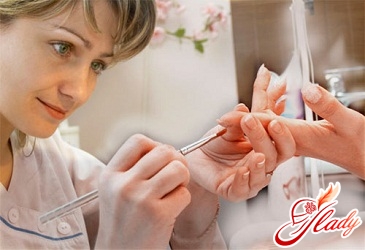 It also happens: salon, in which you are accustomed to doing a manicure - quite a decent level, and the masters who work there - are real professionals, and you can not do any manicure! There are situations when a manicure is contraindicated because of a bad condition of the skin or nails. And even if the disease has not yet manifested itself completely, the manicure procedure can provoke an exacerbation. When is a visit to the salon replaced by a visit to the doctor? Fungal disease. Fungus on the nails - not so rare. Underestimate it is impossible, because sick nails become a source of infection for others. A person with a fungus is dangerous for everyone with whom he comes into contact. Symptoms of the disease: the nail becomes coarse, thickened, fissures. The color of the nail changes from yellowish to brown. At the very beginning of the disease, as soon as the spores of the fungus get on the skin, there are no visible changes, only the itch is felt. But already at this stage it is very important to begin treatment, otherwise the mycelium will germinate into the nails, and it will be much more difficult to treat it. Naturally, to visit the manicure room, if you suspected a fungus, you should not. Not only will you put the risk of infecting the master and other clients, but also during your procedure the fungus can be brought from sick nails to healthy ones. During illness or for the prevention of fungal diseases, use special antifungal nail polish, which are sold in any pharmacy. Separation of the nail plate. The detachment or complete separation of the nail plate from the nail bed usually occurs after trauma or a severe injury. This can happen after infection or as a result of reaction to certain medications (antibiotics). The detachment of the nail is usually accompanied by the appearance of a large bruise under the nail plate and severe pain for several days. If you want to do a manicure while you have such a disaster, then do it only on healthy fingers. The finger on which the nail has peeled off should not be disturbed. Some special treatment is not required - you just have to wait until the nail grows. In extreme cases, the doctor can prescribe you a vitamin intake. Inflammation of the base of the nail. The skin around the nail becomes red and swollen, in some cases even festering occurs. Most often this happens after an injury. Another such inflammation can be caused by bacteria or yeast fungi. Inflammation is treated with the help of Vishnevsky ointment. The ointment is applied to the base of the nail, then the finger should be wrapped with a polyethylene film and left so for the night. Warts around the nails. Warts are considered a viral disease. They have the form of rigid nodules, towering above the level of the skin. Warts grow not only in height, but also in depth. There are many different folk ways of treating warts, but it is wiser to contact a dermatologist. Skin diseases. In no case can you do a manicure for purulent skin diseases. If you are sick with eczema, then visiting the nail salon for you is also very undesirable. Numerous wounds in the skin lesions can become a real gate for any infection or fungus. In addition, contact of the skin with chemicals can cause severe exacerbation of the disease. Some skin diseases can be transmitted by contact with carriers of infection. Any manicurist knows about this and will not give you a manicure if he suspects that your skin is not all right. Non-infectious diseases of the skin - psoriasis, vitiligo (skin pigmentation disorder), acne and the like - are not an obstacle to visiting the manicure cabinet. Deep burrs. Usually burrs are caused by insufficient nail care. A hangnail can be very painful, because bacteria penetrate through the damaged area of the skin and the wound becomes inflamed. A good manicure usually prevents the appearance of burrs or helps to cope with those already available. If you have deep, inflamed burrs, with a manicure you will have to wait. You must first treat your hands - do emollient baths, every day rub into the cuticle oil or cream for hands and nails. Do not forget to wipe the wounds with a disinfectant solution, or at least wash your hands with soap more often. When the burrs heal, go to the manicure. And remember that only regular care will help your hands and nails always be healthy and beautiful.
It also happens: salon, in which you are accustomed to doing a manicure - quite a decent level, and the masters who work there - are real professionals, and you can not do any manicure! There are situations when a manicure is contraindicated because of a bad condition of the skin or nails. And even if the disease has not yet manifested itself completely, the manicure procedure can provoke an exacerbation. When is a visit to the salon replaced by a visit to the doctor? Fungal disease. Fungus on the nails - not so rare. Underestimate it is impossible, because sick nails become a source of infection for others. A person with a fungus is dangerous for everyone with whom he comes into contact. Symptoms of the disease: the nail becomes coarse, thickened, fissures. The color of the nail changes from yellowish to brown. At the very beginning of the disease, as soon as the spores of the fungus get on the skin, there are no visible changes, only the itch is felt. But already at this stage it is very important to begin treatment, otherwise the mycelium will germinate into the nails, and it will be much more difficult to treat it. Naturally, to visit the manicure room, if you suspected a fungus, you should not. Not only will you put the risk of infecting the master and other clients, but also during your procedure the fungus can be brought from sick nails to healthy ones. During illness or for the prevention of fungal diseases, use special antifungal nail polish, which are sold in any pharmacy. Separation of the nail plate. The detachment or complete separation of the nail plate from the nail bed usually occurs after trauma or a severe injury. This can happen after infection or as a result of reaction to certain medications (antibiotics). The detachment of the nail is usually accompanied by the appearance of a large bruise under the nail plate and severe pain for several days. If you want to do a manicure while you have such a disaster, then do it only on healthy fingers. The finger on which the nail has peeled off should not be disturbed. Some special treatment is not required - you just have to wait until the nail grows. In extreme cases, the doctor can prescribe you a vitamin intake. Inflammation of the base of the nail. The skin around the nail becomes red and swollen, in some cases even festering occurs. Most often this happens after an injury. Another such inflammation can be caused by bacteria or yeast fungi. Inflammation is treated with the help of Vishnevsky ointment. The ointment is applied to the base of the nail, then the finger should be wrapped with a polyethylene film and left so for the night. Warts around the nails. Warts are considered a viral disease. They have the form of rigid nodules, towering above the level of the skin. Warts grow not only in height, but also in depth. There are many different folk ways of treating warts, but it is wiser to contact a dermatologist. Skin diseases. In no case can you do a manicure for purulent skin diseases. If you are sick with eczema, then visiting the nail salon for you is also very undesirable. Numerous wounds in the skin lesions can become a real gate for any infection or fungus. In addition, contact of the skin with chemicals can cause severe exacerbation of the disease. Some skin diseases can be transmitted by contact with carriers of infection. Any manicurist knows about this and will not give you a manicure if he suspects that your skin is not all right. Non-infectious diseases of the skin - psoriasis, vitiligo (skin pigmentation disorder), acne and the like - are not an obstacle to visiting the manicure cabinet. Deep burrs. Usually burrs are caused by insufficient nail care. A hangnail can be very painful, because bacteria penetrate through the damaged area of the skin and the wound becomes inflamed. A good manicure usually prevents the appearance of burrs or helps to cope with those already available. If you have deep, inflamed burrs, with a manicure you will have to wait. You must first treat your hands - do emollient baths, every day rub into the cuticle oil or cream for hands and nails. Do not forget to wipe the wounds with a disinfectant solution, or at least wash your hands with soap more often. When the burrs heal, go to the manicure. And remember that only regular care will help your hands and nails always be healthy and beautiful.
How often can you do a manicure without harm to your health?
In order for your nails to look healthy andwell-groomed, and the skin shone with freshness and youth, it is enough to undergo manicure and pedicure treatment not more often than once a month. The rest of the time it is enough to take care of the nails alone at home. It is worth remembering that at home you must remember your safety. It is not enough to decide which manicure set is better. After all, no the best manicure set will not be able to replace you with all cosmetic products for nails. First of all, be careful about the choice of nail care products. Unfortunately, the market has a lot of various means that contain toxic chemicals. The composition of some polishes for nails is such that it can not only damage the texture of the nail, but also cause damage to the skin and even affect the nervous system. Some chemicals can cause a violation of the functions of the internal organs of man. Buying nail care products, think not only about how to spend less money. Think about how not to hurt your health. Carefully read the ingredients of the ingredients, if you are confused - consult a manicurist who you trust. Use only high-quality products of famous brands. Buying polishes and varnishes, consider the state of your nails. If your nails are fragile and constantly break down, most likely, you have a lack of calcium. You should buy such a lacquer, which additionally contains calcium in its composition. To care for problem nails, which grow poorly, break down or break down, it is necessary to use the means of only the best quality. Both the base and the top coating should have in their composition such substances that not only will not dry or thin the nail plate, but on the contrary, they will nourish and moisten. Knowing all the rules of safety during the manicure, you can always look good, staying healthy. After all, if you are not alien to such concepts as beauty and health, a manicure will always be present in your personal beauty program. And your beautiful hands will really become your calling card! We advise you to read:




